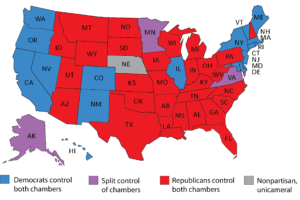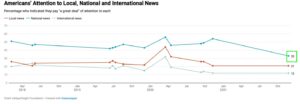Now that we are into the 2022 primary season, it’s time to lay down some markers on how to evaluate Donald Trump’s candidate endorsement strategy, which will inevitably get attention. I offered some preliminary thoughts at New York:
Ever since he became president, Donald Trump has made a habit of endorsing a lot of candidates for office. According to Ballotpedia, as of today, he has endorsed a total of 497 primary- or general-election candidates, 192 of them since leaving the White House. Trump, of course, claims his endorsements have been a smashing success. A day after his attempt to get revenge on his Georgia enemies failed spectacularly, he was boasting of his prowess on Truth Social:
“A very big and successful evening of political Endorsements. All wins in Texas (33 & 0 for full primary list), Arkansas, and Alabama. A great new Senatorial Candidate, and others, in Georgia. Overall for the “Cycle,” 100 Wins, 6 Losses (some of which were not possible to win), and 2 runoffs. Thank you, and CONGRATULATIONS to all!”
But is Trump actually a midterms kingmaker? The answer is a bit trickier than simply checking his math. The former president has been furiously padding his win record by backing unopposed House incumbents in safe seats, so the numbers don’t tell us much. Instead, let’s look at the objectives behind his aggressive midterms enforcement strategy and how well he’s meeting each goal.
Trump wants to keep the focus on himself.
Everyone knows Trump is self-centered to an extreme degree, but there is a rational motive for him wanting to enter every political conversation: It keeps his name in the news and his opinions on people’s minds. This requires some effort given Trump’s loss of key social-media outlets and of the levers of presidential power.
He’s meeting this objective well so far. It’s a rare 2022 Republican primary in which Trump’s support or opposition is not an issue of discussion. He has endorsed 16 gubernatorial candidates, 17 Senate candidates, 110 House candidates, 20 non-gubernatorial statewide elected officials, and even 18 state legislators and three local elected officials. That means a lot of jabbering about Trump and a lot of speculation about who might win his support. And even where his candidates have fallen short, the signature MAGA themes of immigration, “election security,” and “America First” have been on most candidates’ lips. Arguably, Trump nemesis Georgia governor Brian Kemp ran a MAGA campaign.
Trump wants to get revenge on his enemies.
Some of Trump’s endorsements are meant to settle old scores with Republicans who thwarted his efforts to reverse his 2020 loss or supported one of his two impeachments. In addition to punishing figures such as Representative Liz Cheney, Trump hopes withholding his support from disloyal Republicans will serve as deterrent to anyone who might disobey him in the future.
This is why the victories of Kemp and Secretary of State Brad Raffensperger in Georgia were so damaging to Trump’s brand: These two men (especially Raffensperger, who not only mocked Trump’s election-theft fables and defied his orders to “find” votes for him but wrote a book about it) stood up to the boss on an important matter and didn’t lose their jobs over it. That could be dangerous for Trump if it continues.
Trump wants to show he still runs the GOP.
Trump demonstrates his power through his ability to instruct Republicans on how to vote and by making his good will the coin of the realm for Republican aspirants to office. From that point of view, the ideal primary for the former president was probably Ohio’s Senate contest on May 3. All but one of the candidates spent months seeking his favor, and the lucky beneficiary of his endorsement, J.D. Vance, surged to victory on the wings of MAGA support. Similarly, in Pennsylvania, Trump managed to get multiple Senate and gubernatorial candidates to dance to his tune before settling on Doug Mastriano for governor (a win) and Mehmet Oz for the Senate (a possible win; his duel with David McCormick has gone to overtime with a recount and a court case).
Trump didn’t do so well in instructing his voters in Idaho, Nebraska, and Georgia, losing gubernatorial primaries in all three. But he barely lifted a finger on behalf of Idaho lieutenant governor Janice McGeachin against Brad Little, and you can’t really blame him for his Nebraska candidate, Charles Herbster, being accused of groping multiple women (though you can certainly blame him for not only sticking with Herbster after the allegations emerged but also advising him to deny everything and fight back).
Here, again, the results in Georgia were devastating for Trump. Voters in the state emphatically rejected Trump’s repeated and incessant instructions to vote again Kemp and Raffensperger; in the gubernatorial race in particular, there was no doubt about his wishes. Yet Kemp won with nearly three-fourths of the vote. That level of voter disobedience hurts.
Trump wants to get in front of the Republican victory parade.
If we assume Trump is running for president in 2024, then it makes perfect sense for him to attach his name to a midterm Republican campaign effort that, for reasons that have nothing to do with him, is likely to be successful. Getting in front of a parade that is attracting larger and more enthusiastic crowds is a surefire way to look like a leader without the muss and fuss of having to make strategic decisions, formulate message documents, raise money, or plot the mechanics of a get-out-the-vote campaign.
Trump’s success in making himself the face of the 2022 Republican comeback will, of course, depend on what happens in November. At least three of his endorsed Senate candidates (four if Oz prevails in the Pennsylvania recount) are already Republican nominees in top November battlegrounds. He has also endorsed Senate candidates in future 2022 primaries in Alaska, Arizona, Florida, Nevada, and Wisconsin, which should be close and pivotal races in November. If the Senate candidates Trump has handpicked underperform (e.g., Georgia’s Herschel Walker, whose personal and business backgrounds have come under scrutiny) or, worse yet, cost the GOP control of the upper chamber, you can bet Mitch McConnell and many others will privately or even publicly point fingers of angry accusation toward Mar-a-Lago. The same could be true in states holding crucial gubernatorial elections.
Portraying himself as the leader of a Republican midterm wave may conflict with some of Trump’s other goals. For example, he may need to put aside his thirst for vengeance against Kemp to back the GOP’s crusade against Democrat Stacey Abrams (whom Trump once said he’d prefer to Kemp). More generally, if Trump makes himself too much of the 2022 story, he could help Democrats escape the usual midterm referendum on the current president’s performance. In that case, 2022 could serve as a personal disaster rather than a bridge to his 2024 return to glory.
Georgia’s primaries presented multiple danger signs for Trump’s 2022 strategy of aligning himself with winners, intimidating his enemies, and remaining the center of attention. But despite his recent setbacks, there are no signs Trump is shifting tactics, and it’s a long way to the final reckoning in November.











